XTM vs SYSTRAN
Pick the right translation solution for your company
Finding the right translation platform can be overwhelming. With so many tools on the market, it's tempting to start with something simple like SYSTRAN. For basic text conversion, it gets the job done—fast, automated, and easy to access.
But as your business grows, so do your localisation requirements. You need structured workflows, quality checks, team collaboration, and integration with your existing content systems. SYSTRAN isn’t designed for that.
XTM fills that gap. It’s a true translation management system with built-in automation, AI visibility, and tools for managing content at scale—all from a single, cloud-based platform.
Book your 30-minute demo
Book your 30-minute demo
Trusted by teams at over 1,000 of the world’s leading organizations
3 reasons to choose XTM
over SYSTRAN
Full control from start to finish
XTM manages your entire translation process from project creation to final file delivery. SYSTRAN just gives you raw machine translation results - you have to do everything else manually.
AI you can see and control
XTM’s Advanced AI Pack shows you how translation decisions are made. You can bring your own AI keys and have full control over the whole process. SYSTRAN uses neural networks that don’t explain their decisions or give you much customisation.
Integrations with your existing tools
XTM integrates with over 60 different platforms, including content management systems, product information management tools and business applications like Adobe Experience Manager and Salesforce. SYSTRAN has much fewer integration options.
The results only XTM can deliver
Whether you’re a localization manager, marketer, or product team, we streamline the entire process—saving time, reducing costs, and boosting quality
increase in translation quality
cost savings on external vendors
faster time-to-market
XTM vs SYSTRAN: What's the difference
It all depends on what your business really needs. SYSTRAN is good if you just need machine translation - changing text without any project structure or team support. It’s designed for output rather than managed localisation processes.
XTM is for businesses that need to run translation projects. This means automated workflows, quality checks, collaboration tools and seamless integration with your existing software setup.
The difference becomes clear when you scale. SYSTRAN users often end up managing everything manually, dealing with email threads and spreadsheets. XTM users get a platform that handles the hard work - tracking project schedules, coordinating suppliers and maintaining quality without manual work.
Feature breakdown: XTM vs SYSTRAN
Running translation projects - XTM vs SYSTRAN methods
Translation is more than just converting words between languages. When you’re managing global content, you need workflows, deadlines, review stages and team collaboration. This is where XTM and SYSTRAN differ the most.
SYSTRAN treats translation as a simple input-output task. You enter text, choose your language pair and get results. This works for small jobs or internal use. But when you’re managing large translation projects with multiple team members, deadlines and approval stages, SYSTRAN hits its limits quickly.
XTM: The full translation management platform
XTM manages the entire translation process from start to finish. It creates projects, assigns tasks, monitors deadlines and reviews. Project managers can see progress in real time, spot delays early and keep work flowing across different time zones and languages.
All changes are recorded automatically, version control happens without manual effort and nothing gets missed. SYSTRAN users usually rely on spreadsheets and email chains for organisation. With XTM everything is in one place, saving time and removing coordination issues.

Quality control - XTM vs SYSTRAN approaches
Good translation requires accuracy, consistency, brand safety and context awareness. XTM and SYSTRAN manage quality control in very different ways.
SYSTRAN focuses on machine translation output. It produces decent text but has no understanding of how or why specific choices are made. There’s no scoring system for quality issues, no built-in review process and no tools for consistency.
Advanced quality control with XTM
XTM builds quality control into every stage of the process. Intelligent Score delivers measurable quality data using industry standards like MQM. You can monitor translation performance instead of guessing about quality levels.
Language Guard spots sensitive information and ensures brand terminology is used correctly. SmartContext shows translators exactly how their work will look in the final design or interface, which matters for apps, websites and marketing materials. These tools work together to reduce errors and maintain content quality from the start.
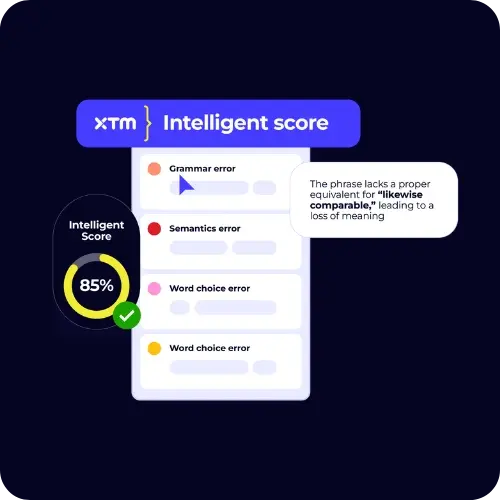
AI capabilities - XTM vs SYSTRAN review
Modern translation AI has moved beyond simple neural machine translation. The differences between XTM and SYSTRAN show how platforms are handling current AI needs.
SYSTRAN built its name on neural machine translation technology. The platform uses proprietary algorithms for text conversion between languages with some domain customisation through corpus uploads. But users get little understanding of translation decision making. This closed approach makes it hard to know why certain translations were chosen or how to improve results systematically.
Smart AI-powered translation with XTM
XTM’s Advanced AI Pack is all about transparency and user control. The platform supports bring-your-own-key integration with leading language models so you have control over AI costs and data handling. Intelligent Workflow uses AI to trigger automated actions based on project conditions while keeping full visibility into decision logic.
The platform’s AI structure provides clear explanations. You can see why specific quality scores were given, how automated routing decisions were made and what factors influenced translation suggestions. This transparency is critical for regulated industries and organisations that need to audit their translation processes.
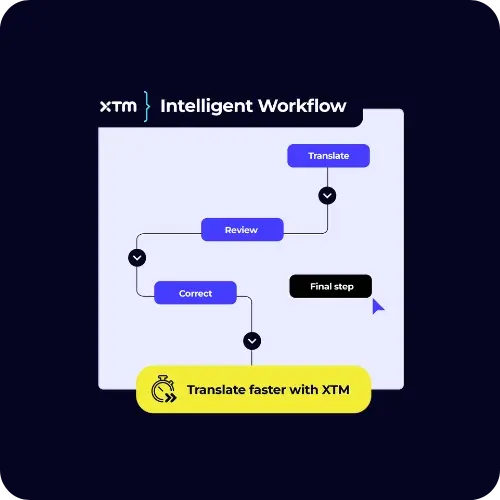
Integration and automation - XTM vs SYSTRAN features
Business translation doesn’t happen in isolation. Modern translation management needs connections with content management systems, development tools and business applications. XTM and SYSTRAN offer very different integration capabilities.
SYSTRAN mainly provides translation APIs and basic integrations for common applications. You can integrate SYSTRAN’s machine translation into existing systems but you’ll need to build most workflow management yourself. This works if you have development resources and simple translation requirements.
Connect your entire technology stack with XTM
XTM has an integrations marketplace with over sixty pre-built connectors. These include popular content management systems, version control platforms like Git, ecommerce platforms and marketing automation tools. The integrations handle complete workflow automation including project creation, file synchronisation and delivery coordination, not just translation.
The platform’s workflow engine lets you create custom automation rules without coding. You can automatically assign projects based on language pairs, route content through specific review processes and trigger notifications when deadlines approach removing manual coordination fully.
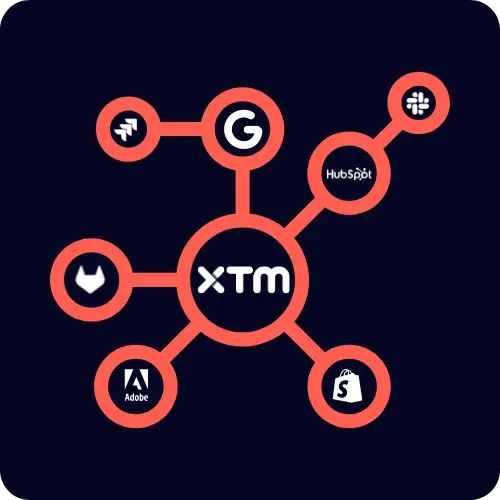
Choose XTM, the superior alternative to SYSTRAN
When you need more than basic machine translation, XTM delivers the complete solution your business needs. Unlike SYSTRAN's limited machine translation method, XTM offers everything required to manage professional translation operations at scale.
Frequently asked questions
Is the XTM vs SYSTRAN comparison suitable for business translation requirements?
Absolutely, although they serve different purposes. SYSTRAN delivers machine translation technology, whilst XTM provides complete translation management. Businesses usually need both translation ability and project coordination, making XTM the more complete solution for professional translation work.
Can SYSTRAN handle complex translation workflows like XTM can?
No, SYSTRAN concentrates only on machine translation without project management features. The XTM vs SYSTRAN comparison reveals clear differences - you'll require extra tools to manage projects, assign tasks, and coordinate teams with SYSTRAN. XTM includes all these abilities in one platform.
How do the prices compare between XTM vs SYSTRAN for expanding businesses?
SYSTRAN might appear cheaper at first since it only delivers machine translation, but you'll need additional tools for project management, quality control, and team collaboration. XTM's all-in-one method often proves more cost-effective as you scale, removing the need for multiple separate solutions.
Which platform manages sensitive data and compliance requirements better in the XTM vs SYSTRAN debate?
XTM provides more robust data security options with on-premise deployment, private cloud hosting, and bring-your-own-key AI integration. SYSTRAN offers basic security but lacks the enterprise-grade compliance features that regulated industries often need for sensitive translation projects.
Take your localization efforts further with XTM
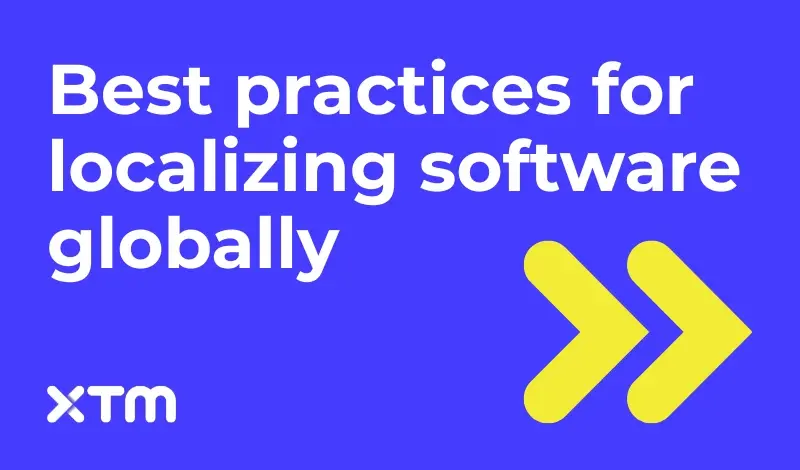
SaaS localization: everything you need to know
A detailed guide featuring best practices for localizing SaaS products—covering UI, workflows, and launch strategies.
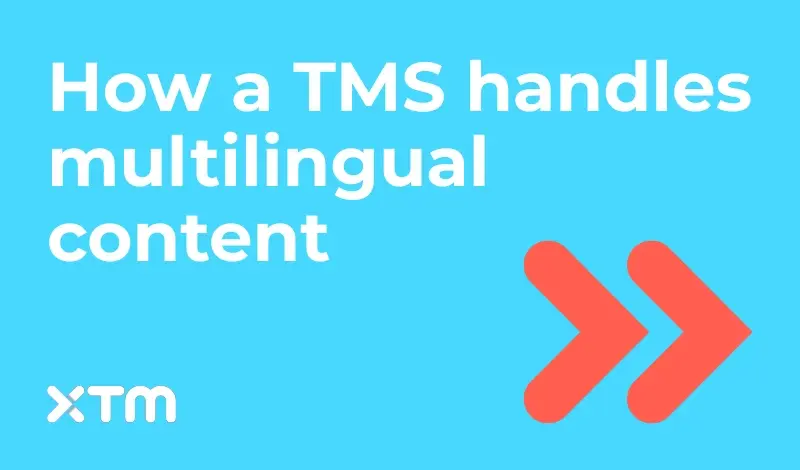
What languages does a TMS support?
Explains TMS capabilities across language variants and local support — demonstrating XTM’s broad language framework.
.webp)
5 top localization tools in 2025 (and how to choose one)
Compare leading localization platforms and learn what features matter most — like multilingual support, visual context, and AI-driven workflow.



%20Request%20pricing%20v2.webp?width=1000&height=200&name=Book%20demo%20CTAs%20(1000%20x%20200%20px)%20Request%20pricing%20v2.webp)